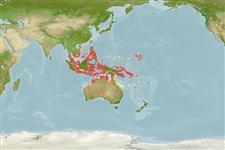>
Eupercaria/misc (Various families in series Eupercaria) >
Labridae (Wrasses)
Etymology: Diproctacanthus: Greek, di = two + Greek, proktos = anus + Greek, akantha = thorn (Ref. 45335).
More on author: Bleeker.
Environment: milieu / climate zone / depth range / distribution range
ນິເວດວິທະຍາ
ສັດທະເລ ກ່ຽວກັນຫີນ; ລະດັບຄວາມເລິກ 2 - 25 m (Ref. 90102), usually 2 - 20 m (Ref. 27115). Tropical; 24°C - 28°C (Ref. 27115); 19°N - 25°S, 99°E - 172°E
Western Central Pacific: Philippines, Palau, Indonesia, New Guinea, and Great Barrier Reef.
ຂະໜາດ / ນ້ຳໜັກ / Age
Maturity: Lm ? range ? - ? cm
Max length : 10.0 cm TL ຕົວຜູ້/ບໍ່ມີເພດ; (Ref. 6023)
ຄີ (ໜາມ)ແຂງຢູ່ຫຼັງປາ (ທັງໝົດ): 9; ຄີຫຼັງຂອງປາ (ຄີອ່ອນ) (ທັງໝົດ): 9-10; ຄີ(ໜາມ) ແຂງຢູ່ຄີກົ້ນປາ
ກຸ່ມປາກະດູກແຂງ
ຄວາມຖີ່ຂອງກຸ່ມຖ່າຍທອດພັນ
ປາທີ່ມີການເຄື່ອນຍ້າຍຈາກທະເລໄປຫານ້ຳຈືດ ແລະນ້ຳຈືດຫາທະເລ
ປາທີ່ມີການເຄື່ອນຍ້າຍຈາກທະເລແລະໄປໄຂ່ຢູ່ນ້ຳຈືດ
ຄີກົ້ນຂອງປາ
ສັດທີ່ມີກະດູກສັນຫັຼງ
ການຖ່າຍທອດທາງກຳມະພັນຈາກພໍ່ແມ່ຫາລູກ 2; ຄີກົ້ນຂອງປາ: 9 - 11; ສັດທີ່ມີກະດູກສັນຫຼັງ: 25. Juveniles with 3 broad black stripes from head to caudal fin where the stripes merge; with growth, lower stripe disappears, upper stripe is less distinct; black caudal fin becomes entirely yellow in adults. Head scales small. Lips thick and fleshy, forming a short tube when mouth is closed. Caudal fin rounded to truncate; pelvic fins rounded.
A solitary species (Ref. 90102) occurring in coral rich areas of shallow lagoons and sheltered seaward reefs. Adults feed mainly on coral polyps while juveniles remove ectoparasites from small territorial fishes (Ref. 2334, 9710). Adults swim in small groups. Usually, only small juveniles clean other fishes (Ref. 48636).
Life cycle and mating behavior
ການຈະເລີນເຕັມໄວ | ການສືບພັນ | ການວາງໄຂ່ | ໄຂ່ | ຄວາມດົກຂອງໄຂ່ປາ | ຕົວອ່ອນ
Oviparous, distinct pairing during breeding (Ref. 205).
Randall, J.E., G.R. Allen and R.C. Steene, 1990. Fishes of the Great Barrier Reef and Coral Sea. University of Hawaii Press, Honolulu, Hawaii. 506 p. (Ref. 2334)
IUCN Red List Status (Ref. 130435)
Threat to humans
Harmless
Human uses
ຕູ້ປາ: ເປັນສີນຄ້າ
ຂໍ້ມູນຕື່ມອີກ
ຊື່ສາມັນຄຳສັບຄ້າຍຄືກັນການເຜົາໃໝ້ພະລັງງານໂດຍປ່ຽນທາດອາຫານໃນຮ່າງກາຍໃຫ້ກາຍເປັນຊີ້ນແລະໜັງຜູ້ລ້າການສຶກສາຜົນກະທົບຂອງສານຜິດທີ່ມີຜົນກະທົບຕໍ່ລະບົບນິເວດການສືບພັນການຈະເລີນເຕັມໄວການວາງໄຂ່ການສັງລວມການວາງໄຂ່ຄວາມດົກຂອງໄຂ່ປາໄຂ່Egg development
ເອກະສານອ້າງອີງການລ້ຽງສັດນ້ຳຂໍ້ມູນການລ້ຽງສັດນ້ຳສາຍພັນກຳມະພັນElectrophoresesການຖ່າຍທອດທາງກຳມະພັນຈາກພໍ່ແມ່ຫາລູກພະຍາດການປຸງແຕ່ງNutrientsMass conversion
ຜູ້ຮ່ວມມືຮູບStamps, Coins Misc.ສຽງຫອຍມີພິດຊະນິດນຶ່ງທີ່ອາໄສໃນທະເລຄວາມໄວປະເພດການລອຍເນື້ອທີ່ເຫືອກOtolithsສະໝອງວິໄສທັດ
ເຄື່ອງມື
Special reports
Download XML
ແຫຼ່ງອີນເຕີເນັດ
Estimates based on models
Preferred temperature (Ref.
123201): 26.8 - 29, mean 28.2 °C (based on 610 cells).
Phylogenetic diversity index (Ref.
82804): PD
50 = 1.0000 [Uniqueness, from 0.5 = low to 2.0 = high].
Bayesian length-weight: a=0.00912 (0.00466 - 0.01787), b=3.06 (2.89 - 3.23), in cm total length, based on LWR estimates for this species & (Sub)family-body (Ref.
93245).
ຊັ້ນເຂດຮ້ອນ (Ref.
69278): 3.3 ±0.61 se; based on food items.
ຄວາມຢືດຢຸ່ນ (Ref.
120179): ສູງ, ປະຊາກອນຕຳ່ສຸດທີ່ໃຊ້ເວລາສອງໜ້ອຍກວ່າ 15 ເດືອນ (Preliminary K or Fecundity.).
Fishing Vulnerability (Ref.
59153): Low vulnerability (10 of 100).
Nutrients (Ref.
124155): Calcium = 121 [70, 214] mg/100g; Iron = 0.854 [0.488, 1.603] mg/100g; Protein = 18.3 [15.5, 20.6] %; Omega3 = 0.162 [0.099, 0.263] g/100g; Selenium = 22.3 [12.7, 40.8] μg/100g; VitaminA = 154 [47, 580] μg/100g; Zinc = 2.07 [1.39, 3.30] mg/100g (wet weight);
